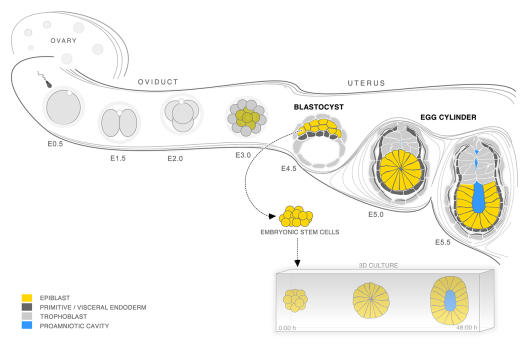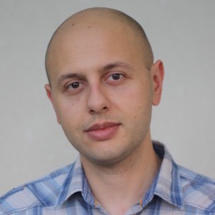Dr. Ivan Bedzhov
Self-organization of the pluripotent lineage in the implanting mammalian embryo

Cell Biology / Molecular Biology
Development
Stem Cell Biology
At day four and a half (E4.5) after fertilization the mouse embryo attaches to the uterine wall and initiates implantation. In turn, the maternal tissues proliferate and engulf the embryo, making it inaccessible for direct observations and experimental manipulations. Therefore, the mammalian development at the time of implantation is largely unexplored and probably the most enigmatic period of the early embryogenesis. In a very short period of time, just within 24 hours, the hollow shaped embryo (blastocyst) radically changes its appearance, transforming into an elongated structure (egg cylinder). At that time the pluripotent cells of the embryo (that later will form all tissues of the body) undergo a remarkable reorganization from a simple ball of cells into a radially polarized epithelium with central lumen. This morphogenic transformation coincides with transcriptional, epigenetic and metabolic changes collectively determined as naïve to primed pluripotency states transition. Using novel 3D embryonic stem cell and embryo culture methods we want to elucidate key factors and signalling circuits that cross-regulate and synchronize these developmental processes.

Vita
- 2000 - 2004: BSc, Molecular biology – University of Sofia, Bulgaria
- 2004 - 2006: MSc, Genetic and cell engineering - University of Sofia, Bulgaria
- 2006: Research associate – Institute of Molecular Biology, Sofia, Bulgaria
- 2007 - 2011: PhD - Max Planck Institute for Immunobiology and Epigenetics, Freiburg, Germany
- 2012 - 2015: Postdoc - Gurdon Institute & Department of Physiology, Development and Neuroscience, University of Cambridge, UK
- Since 2015: Principal investigator - Max Planck Institute for Molecular Biomedicine, Münster, Germany
Selected references
Bedzhov I, Bialecka M, Zielinska A, Kosalka J, Antonica F, Thompson AJ, Franze K, Zernicka-Goetz M. (2015). Development of the anterior-posterior axis is a self-organising process in the absence of maternal cues in the mouse embryo. Cell Research 25,1368–1371
Bedzhov I, Zernicka-Goetz M. (2014). Self-organizing properties of mouse pluripotent cells initiate morphogenesis upon implantation. Cell 156, 032–1044
Bedzhov I, Bialecka M, Leung CY, Zernicka-Goetz M. (2014). In vitro culture of mouse blastocysts beyond the implantation stages. Nature Protocols, 9, 2732–2739
Bedzhov I, Alotaibi H, Basilicata MF, Ahlborn K, Liszewska E, Brabletz T, Stemmler MP. (2013). Adhesion, but not a specific cadherin code, is indispensable for ES cell and induced pluripotency. Stem Cell Research 11, 1250-63
Bedzhov I, Liszewska E, Kanzler B, Stemmler MP. (2012). Igf1r signaling is indispensable for preimplantation development and is activated via a novel function of E-cadherin. PLoS Genetics 8, e1002609
Links
